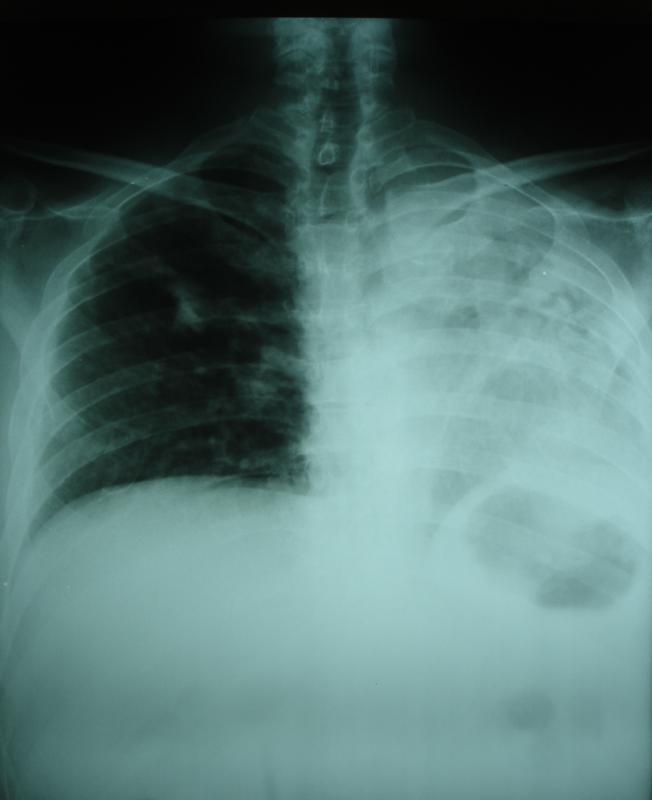At WiseGEEK, we're committed to delivering accurate, trustworthy information. Our expert-authored content is rigorously fact-checked and sourced from credible authorities. Discover how we uphold the highest standards in providing you with reliable knowledge.
What is the Pleural Cavity?
The pleural cavity is an area which surrounds the lung. Each lung is inside an isolated pleural cavity, with the lungs forming inside the cavity during fetal development. This space inside the body is formed between the parietal and visceral pleura which line the lungs and body cavity. It allows room for the lungs to expand and contract, and is designed to make it easy for the lungs to inflate after they have deflated. If problems develop inside the pleural cavity, people can experience difficulty breathing.
This structure is also known as the pleural space or pleural membrane. In healthy human beings, it is filled with a small amount of fluid which acts as a lubricant. As the lungs inflate, the lubricant allows the pleura to slide without resistance so that the lungs can expand and as they deflate, it reduces friction inside the pleural cavity so that the lungs deflate smoothly. Like other body fluids, pleural fluid cycles continuously, with the body constantly making more of the fluid while excess old fluid is carried away.

One problem which can emerge in the pleural cavity is mesothelioma, a type of cancer which attacks the tissues found in the pleural cavity. People most commonly develop this cancer as a result of exposure to asbestos, which irritates the lungs and contributes to the eventual development of tumors. These tumors can spread quickly, and they are difficult to eradicate successfully, especially if the cancer is caught late.

Another issue which can happen is pleural effusion, in which too much fluid builds up inside the pleural cavity, making it difficult to breathe. This condition is often associated with chronic conditions like congestive heart failure. Patients can also experience pneumothorax, in which the pleural space fills with air, usually as a result of trauma. It is important to note that because the pleural cavities are separate, it is possible to have a problem on one side and not the other.

Medical imagining studies of the chest can reveal this anatomical structure and provide information about any problems or areas of malfunction, as well. For example, in someone with pleural effusion or pneumothorax, the pocket of fluid or air can be seen on an x-ray. Other imaging such as MRI can be used to gather more data, including sectional views which provide imaging of the lungs from different angles. These views can be useful for pinpointing the extent of a problem in the lungs.
AS FEATURED ON:
AS FEATURED ON:













Discussion Comments
My husband has pleural effusion because blood clots collapsed his lung. It has gelled and needs to have surgery to remove it. Do you have any video or reports about the surgery?
@David09 - I would think any condition which would contribute to heart failure could be pegged as the culprit, which could be obesity, high blood pressure, smoking and diabetes to name a few. If your friend had any of these conditions then that could be the cause of her disease and the fluids in the pleural cavity.
I knew someone with congestive heart failure, and she told me she had fluid in her lungs, which I never really understood until now. She survived and I never understood why she had the condition, because she was in her early 30’s.
She survived but never gained 100% use of her heart as before. I’m still not clear as to how such a condition could develop, especially in someone so young. I don’t know if she was a smoker or if that could have been a contributing factor if she was.
Our local TV station is constantly running ads for people with asbestos related mesothelioma who need legal to claim damages for their injuries. I’ve never understood what the condition was except that it was a breathing difficulty of some sort. Now I see that it’s a pleural cavity disease.
The thing that concerns me is that the symptom of mesothelioma, shortness of breath, is so common that it could apply to so many other ailments, including something as serious as heart disease or as benign as simply being out of shape or sleep apnea.
It’s important that the public be self-educated about all the possible causes for their symptoms, because doctors may not always nail the cause down right in the first visit.
Post your comments